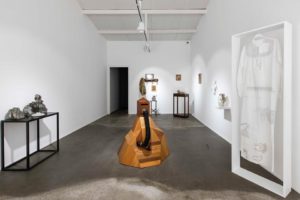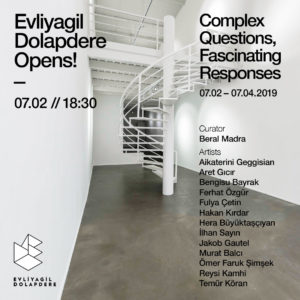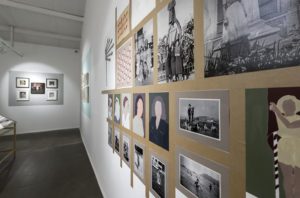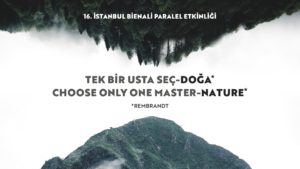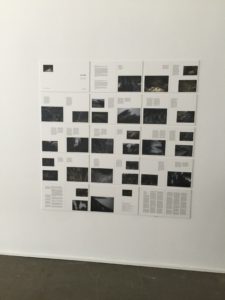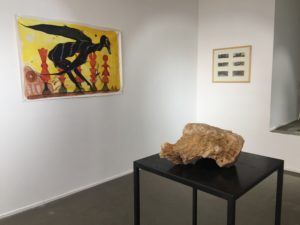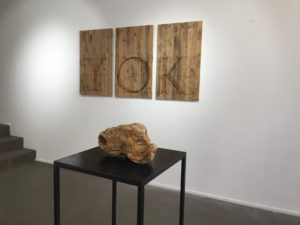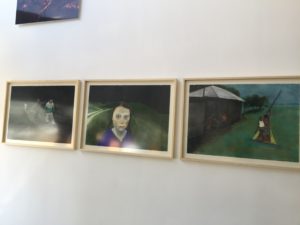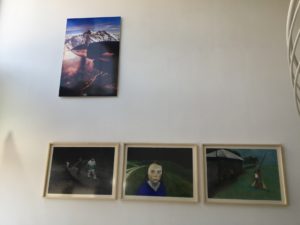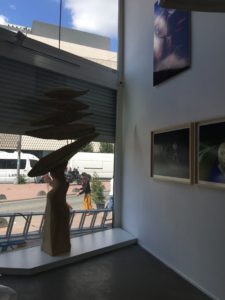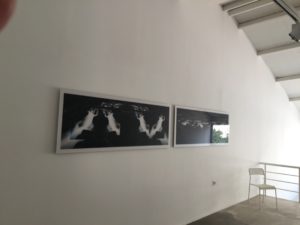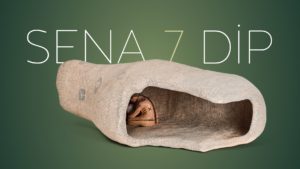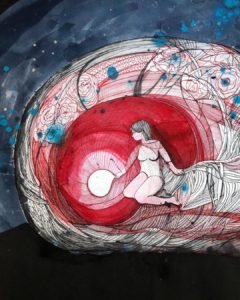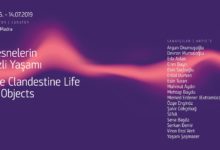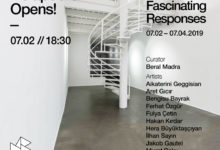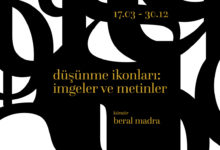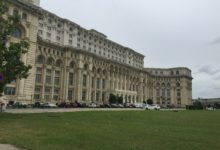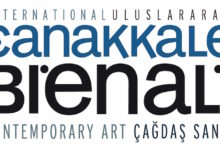“Karmaşık Sorular, Büyüleyici Yanıtlar” 07.02-07.04.2019
Küratör: Beral Madra
Basın Toplantısı:7 Şubat 2019, 10.00-11.30Açılış: 7 Şubat 2019, 18.30
Evliyagil Dolapdere, çok fonksiyonlu ve kar amacı gütmeyen yeni sergi mekanını 2019 Şubat ayında açmaya hazırlanıyor. Mekanın esas amacı; sanatçılar, sanat eleştirmenleri, farklı alanlardan katılım sağlayan izleyiciler ve koleksiyonerler arasında çağdaş sanat üretimlerinin ve diyaloglarının gerçekleşeceği bir sergi alanı yaratmak. Evliyagil Dolapdere’nin 2019 yılı boyunca gerçekleşecek sergilerinin küratörlüğünü Beral Madra üstleniyor.
Evliyagil Dolapdere’nin “Karmaşık Sorular, Büyüleyici Yanıtlar”adlı açılış sergisi, Aikaterini Geggisian,Aret Gıcır,Bengisu Bayrak, Ferhat Özgür, Fulya Çetin, Hakan Kırdar, Hera Büyüktaşçıyan, İlhan Sayın, Jakob Gautel, Murat Balcı, Ömer Faruk Şimşek, Reysi Kamhi ve Temür Köran’ın üretimlerini bir araya getirecek.
Evliyagil Dolapdere, Jakob Gautel’in gerçekleştireceği “Big Brother (Diktatör)” adlı kışkırtıcı performans videosunu sezonun “Karmaşık Sorular, Büyüleyici Yanıtlar”adlı ilk sergisinin açılışında ağırlamaya hazırlanıyor.
KARMAŞIK SORULAR, BÜYÜLEYİCİ YANITLAR
Günümüz görsel sanat üretimlerinin dışavurumları nelerdir, ve bu dışavurumları irdelemek ve çözümlemek üzere davet edilen izleyicinin tepkisi ne olmaktadır? Sürmekte olan tüm bu karşılıklı etkileşim, sanatçı açısından kendine özgü sanatsal bir kelime haznesi geliştirebilmek, ve izleyici açısından da bu kelime haznesinin anlamlarını keşfedebilmek üzere oluşturulan özgün bir arayışa dayanmaktadır. Bu karşılaşma, bir serginin, toplumun kültürel gelişimine sunabileceği bir sinerji için kaçınılmazdır.
“Karmaşık Sorular, Büyüleyici Cevaplar” sergisinin görsel dili kimliklerin ve olayların hikayeci oluşumuna dayalı önemini yitirmiştir. Betimleme, klasik sanatın belirleyici ve sembolik aracısı olmuştur, ancak nasılsa günümüzün görsel gerçekliklerine gereken karşılığı verebilecek yeterli düşünsel güce sahip olamamıştır. Ancak, son otuz yıldan beri hikayeci görsel kelime haznesi bir canlanma yaşamıştır, ve hikayesel ve anlamsal bir örüntüye sahip olan sanat eserleri, izleyiciye taze ve mücadeleci bir yorumlama ve beğeni imkanı sunmaktadır. Hiç şüphesiz bu hikayeci eserler, sanat tarihi ile ilişkili eserlerin masum ve anlam dolu imgelerinden çok uzaktadır. Bu eserler izleyicinin bakış açısını, manipülasyona uğramış siyasi görsel dil tarafından kendisine empoze edilenlere karşı yeni bir değer biçmek ve yeni bir analizde bulunmak için harekete geçirebilen bir takım neo-sürrealist ve psikolojik öğeler, ve rahatsız edici, izleyiciye meydan okuyan, lanetli imgeler barındırır.
Beral Madra Ocak 2019
Press Release
“Complex Questions, Fascinating Responses” 07.02-07.04.2019 Curator: Beral Madra
Press Meeting:7 February 2019, 10.00-12.00Opening: 7th February 2019, 18.30
February 2019, Evliyagil Dolapdere Gallery is opening its multifunctional non-profit gallery space to exhibit diverse forms of contemporary art productions. The gallery is motivated to provide an environment for contemporary art productions and dialogues between artists, art critics , diverse audiences and collectors… 2019 Exhibitions will be curated by Beral Madra.
The opening exhibition of Evliyagil Dolapdere Gallery entitled “Complex Questions, Fascinating Responses” will present works of Aikaterini Geggisian, Aret Gıcır, Bengisu Bayrak, Ferhat Özgür, Fulya Çetin, Hakan Kırdar, Hera Büyüktaşçıyan, İlhan Sayın, Jakob Gautel, Murat Balcı, Ömer Faruk Şimşek, Reysi Kamhi and Temür Köran.
The gallery is proud to present a provoking performance video by Jakob Gautel, “Big Brother” during the opening of “Complex Questions, Fascinating Responses”
COMPLEX QUESTIONS, FASCINATING RESPONSES
What are the manifestations of today’s visual art productions? And what is the reaction of the viewer, who is invited to study and decipher these manifestations? All of this ongoing interaction relies on developing a distinctive artistic vocabulary on the side of the artist and a genuine search for the meaning of this vocabulary on the side of the viewer. This encounter is inevitable for a synergie that an exhibition can offer to the cultural expansion of the society.
The visual language of this exhibition is based on narrative constitution of identities and incidents. Throughout the many epochs of 20th century contemporary art “narrative” became out of favor rendering in the visual vocabulary. Representation was the indicative and symbolic mediator of classical art and was somehow not so intelligent enough for today’s visual realities. However since three decades narrative visual vocabulary experienced a revival and art works with narrative complexity and ambiguity offer a fresh and challenging interpretation and appreciation. No doubt these narrative works are far from the innocent and purposeful imagery of the art-historical works.
Beral Madra
THE CLANDESTINE LIFE OF OBJECTS
The exhibition in Evliyagil Dolapdere will focus on the uncanny or abject objects created over the last two decades. These works reflect the all-powerful presence of these investigative three-dimensional works in the socio-cultural environment of Turkey as well as the strength of the artists purpose of visually fabricating and presenting objects, which provoke the society of spectacle into facing an uncanny effect.
The term uncanny first appears at Ernst Jentsch’s 1906 essay, On the Psychology of the Uncanny (1) and it was particularized by Freud’s 1919 essay The Uncanny. Jentsch defined the uncanny as a product of intellectual uncertainty and Freud rejected this uncertainty: There is no question, therefore, of any “intellectual un- certainty”; we know now that we are not supposed to be looking on at the products of a madman’s imagination behind which we, with the superiority of rational minds, are able to detect the sober truth; and yet this knowledge does not lessen the impression of uncanniness in the least degree. The theory of “intellectual uncertainty” is thus incapable of explaining that impression (2). He associated the uncanny with the realm of his aesthetic investigations, which later influenced Surrealism.
In Being and Time (1927) (3), Heidegger describes the feeling of not being at home with oneself, or to be estranged about something, as uncanny, which corresponds to Freud’s: The uncanny was not to be found in the exotic but in the everyday. In other words, one can have the same feeling of strangeness when one encounters objects which are not common or everyday objects. This feeling also includes any kind of alienation that becomes effective through the complex and insecure socio-political and cultural environments emerging since the beginning of 20th century. Julia Kristeva, in her essay Abjection: Powers of Horror refers to Freud: Freud had strongly emphasized, at the outset of Totem and Taboo, “man’s deep aversion to his former incest wishes”. He had reminded us of the properties of the taboo: it is “sacred, consecrated; but on the other hand it means uncanny, dangerous, forbidden and unclean” (4). In her essay, the abject is described as something rejected from which one does not part, from which one does not protect oneself as from an object. Imaginary uncanniness and real threat, it beckons to us and ends up engulfing us. In the aesthetic realm of Post-modernism and relational aesthetics, Abject and Uncanny became key terms for objects that have a function and perspective related to all these philosophical and psychoanalytical discourses.
The uncanny artworks can thrust the viewer into a confrontation with the unusual, insecure and unfamiliar; all these conditions evoke the deep-rooted fear in front of the alienated, the obscure and the clandestine. However, the paradox is that these artworks are mainly preoccupied with ordinary subject matter and with the everyday in all its familiarity; and it is precisely this aspect which justifies Freud’s statement. In other words, he specifies that what used to be well-known, becomes weird and that this peculiar transformation is frightening.
When viewing a work that deserves the term uncanny we can ask several questions: How can this work created with familiar forms and everyday articles be connected to the uncanny experience? What are the socio-cultural implications of these alien and dissimilar components that are combined into an entity? How does the imaginary preconception perceive the psychosomatic dimensions of this uncanny work? What is the spiritual effect of this familiarity against rejection or oppression?
One can also argue that in the Freudian discourse, the uncanny is emphasizing the social and political disposition of the unconscious. The work fluctuates between actuality and ingenuity, attraction and repulsion, familiarity and unfamiliarity. If the intention of the artist is to create a representational strategy of moving towards a crucial awareness, -this is not immediate and striking but has a paradoxical quality- which again is intentional. At first, the components of the work represent familiarity and everyday reality, which predominantly represent the status quo or consumption culture. At the second level, the combination of these images creates the strangeness which confuses the desire of consumption and the reality of status quo.
The uncanny had many appearances throughout the centuries, from the Paleolithic and Neolithic up to Surrealism and today’s interdisciplinary and relational aesthetics. The Venuses of Europe’s tool-making Gravettian culture, created between 22,000 and 27,000 years ago; the Neolithic images on the walls of cave dwellings in Anatolia; the narration of Christianity on church walls or on icons have provoked an uncanny effect on the past and present viewers through the use of strange, weird, alien figures, animals, environments; they have always been distressing and repulsive as they have been fascinating and alluring.
20th century avant-gardes, consuming Freud’s analytical approach to the unconscious, created surrealistic images that expose all the characteristics of the uncanny. Dreams, memory, recollections associations, horror, anxiety became tools for representing the human condition of their time. The legendary film of Louis Bunuel and Salvador Dali, Un Chien Andalou (1944) is the most effective example of this approach. As soon as the everyday objects were presented as an art object by Marcel Duchamp through his Pissoir – a most bizarre object to be displayed in a traditional art exhibition – the path to the uncanny art production was opened. Even if this phantasy of duality also opened the path of inquiry into the status of the art object, artists laboriously created uncanny objects using new techniques and materials. Today, when we look at these works, we even think that in their appropriation of everyday objects, they are realistic but also surreal. The works of Hans Bellmer, Meret Oppenheim, Francis Bacon, Louise Bourgeoise, Mike Kelley, Robert Gober, Bruce Nauman, Edward Kienholz, Paul McCarthy, Sarah Lucas, Ron Mueck, Marc Quinn, Jake and Dinos Chapman, Patricia Piccinini and many others are defined as animistic, magic, abject, uncanny and are associated with sorcery, and categorised as uncanny and provoked a suppressed primordial fear, intellectual uncertainty. In the uncanny works, one can even perceive an omnipotence of thought, an accidental reappearance, a paired and castrated image. In Turkey’s Post-modern art production an early example of an uncanny object is the IV Appearance of Altan Gürman (1974), a simple 70 cm schematic figure made of paper and cellulose which confronted all stereotype convictions about the meaning and aesthetic of Modernist sculpture. Another example is Kuzgun Acar’s Masks (1973), created for the play Caucasian Crayon Circle of Bertolt Brecht. Gülsün Karamustafa’s, Double Truth, 1987 and Füsun Onur’s Untitled Füsun Onur (1993); a chair with chains reflect the feminist uncanny.
In the age of Post-truth, late-Neocapitalism and socio-political turmoil, the everyday life of people is to suffer under the symptom of continuous risk, which creates a culture of fear, so that sociologists define it as an age of anxiety. Artists who use the meaning and purpose of art for their socio-political opinions and concerns response to these circumstances with artworks that exploit the collective and individual anxiety through elusively combining the real and the surreal, the domestic and the jeopardy.
The exhibition presents several ways of creating uncanny objects.
Ekin Saçlıoğlu ‘s traditional domestic corner of cloth rack with pelts, horns and bone, Eda Aslan‘s vegetative bookshelf, Memed Erdener ‘s wooden vacuum cleaner and Sena Başöz‘s black cabinet filled with precious pieces of statuettes are strangely processed furnitures in sculptural terms. They approached the uncanny concept by considering the physical and tactile qualities of these common furnitures, but diverting their familar features into engrossing images. The other way of reflecting the Freudian uncanny is evidently gives the artist the possibility to enter into the mysteries of human body, sexuality and gender concerns. Yaşam Şaşmazer‘s distorted heads with fungous, Erdal Duman‘s gold femur, Sena’s feet that does not sink into the water, Mahmut Aydın‘s mutilated body and Serkan Demir‘s innoecent looking emergency stretch captivates the gaze of the viewer towards an unfathomable interpretation and perception. Three works, the white wedding gown with images of Freudian dreams of Esin Turan, the grotesque white sexy shoes of Mehtap Baydu and Black Tie and Belt of Şakir Gökçebağ, intentionally placed next to each other in the exhibition, extends the Freudian uncanny to the source of today’s gender issues. Erim Bayrı with his metal structure reminiscent of traditional construction material and equipment, and the gloomy iron potted flower, Devran Mursaloğlu, with her handicraft black paper rythmically climbing to the wall and Özge Ezginöz with her synthetic ludicrous plants borrowed from nature confronts the viewer with their material based works that are imparting abstract ideas not only visually perceptible but also comprehensible only with thinking and speculation. Argun Okumuşoğlu tests the humor of the viewer with a colossal divers bust, who possesses a yellow submarine in his googles. Viron Erol Vert submits into the arena of the uncanny three workers helmets created with the most delicate material, porcellain.
BERAL MADRA 2019
NESNELERİN GİZLİ YAŞAMI
Evliyagil Dolapdere’de gerçekleşecek olan sergi, 20 yıl boyunca üretilmiş olan tekinsiz (uncanny) ve itici nesnelere odaklanıyor. Bu yapıtlar, Türkiye’nin sosyo- kültürel ortamı içindeki araştırmacı ve üç boyutlu işlerin mutlak güce sahip varlıklarını ve aynı zamanda da sanatçıların, gösteri toplumunu tekinsiz bir etkiyle yüzleştiren nesneleri görsel olarak yaratma ve sunma niyetlerindeki gücü de yansıtıyor.
Tekinsiz terimi, ilk kez Ernst Jentsch’in 1906 tarihli “On the Psychology of the Uncanny” [Tekinsiz’in Psikolojisi Üzerine] makalesinde ortaya çıkar ve Freud’un 1919 tarihli “The Uncanny” [Tekinsiz] adlı makalesi ile daha fazla ayrıntılandırılır. Jentsch tekinsizi düşünsel bir belirsizliğin ürünü olarak tanımlar, ancak Freud bu belirsizliği yadsır; “Herhangi bir soru yoktur, bu sebeple, herhangi bir düşünsel belirsizlikten de söz edilemez, artık biliyoruz ki bizler, rasyonel akılların sağladığı üstünlükle arkasındaki saf gerçeği saptayacağımız bir delinin hayal gücünün ürünlerine bakmamalıyız; ancak bu bilgi tekinsizliğin etkisini zerre kadar azaltmıyor. Dolayısıyla “düşünsel bilinmezlik” kuramı bu etkiyi açıklamakta yetersiz kalır”. Freud tekinsizi daha sonra Sürrealizmi etkisi altına alacak olan kendi estetik araştırmalarının dünyası ile özdeşleştirir.
Heidegger, 1927 tarihli kitabı Varlık ve Zaman’da, tekinsizi Freud’un “Tekinsiz sıradışı olanda değil gündelik olanda barınır” söylemi ile örtüşen, kişinin kendisini bulunduğu yere ait veya evindeymiş gibi hissetmeme durumu ya da bir şeye karşı yabancılaşmış olma hissiyatı ile tanımlar. Diğer bir deyişle, kişi günlük kullanıma ait olmayan nesneler ile karşılaştığında aynı garipseme hissine kapılabilir. Bu hissiyat, aynı zamanda 20. yüzyılın başından beri etkisini sürdüren karmaşık ve güvensiz sosyo-politik ve kültürel ortamlar içinde etkin bir biçimde var olan her türlü yabancılaşmayı da kapsar. Julia Kristeva, makalesi Abjection: Powers of Horror’da [Bayağılık: Korkunun Güçleri] Freud’a gönderme yapar: Freud, Totem ve Tabu’nun ilk bölümünde “insanların geçmişte sahip oldukları ensest arzulara karşı duydukları derin nefret” kavramına yoğun bir vurgu yapar. Bizlere tabuların şu özelliklerini yeniden hatırlatır: “tabular kutsal, ancak öte yandan da tekinsiz, tehlikeli, yasaklı ve günahkarlardır.” Kristeva iticiyi [Abject] şöyle tanımlar: İtici, tıpkı ayrılamadığımız, kendimizi koruyamadığımız bir nesne gibi dışarı atılandır. Hayali tekinsizlik ve gerçek tehdit bize işaret eder, ve en sonunda bizi tamamen yutup içine çeker. Post- modernizm ve İlişkisel Estetikte İğrenç ve Tekinsiz kavramları, işlev ve perspektif bakımından tüm bu felsefi ve psikanalitik söylemler ile ilişkili olan nesneler için anahtar terimler haline gelirler.
Tekinsiz sanat eserleri izleyiciyi olağan olmayanla, güvensiz ve yabancı olanla yüzleşmeye iter; bütün bu koşullar yabancılaşmış, belirsiz ve gizli olan karşısındaki köklü korkuları uyandırır. Ancak buradaki çelişki aslında şudur: bu yapıtlar sıradan, bildik ve gündelik olanla uğraşır; ve Freud’un ifadesini meşru kılan bakış açısı da tam olarak budur… Diğer bir deyişle, Freud geçmişte iyi bilinen bir şeyin git gide garipleşmesini ve bu tuhaf dönüşümün korkunçluğunu anlatmaktadır.
Tekinsiz kavramını hak eden bir yapıta bakarken, yapıta yöneltebileceğimiz bir takım sorular vardır: Tanıdık biçimler ve gündelik nesnelerle yaratılmış olan bu iş, tekinsiz deneyim ile nasıl bağlantılı olabilir? Yabancı ve birbirinden farklı bileşenlerin bir araya gelerek oluşturduğu bu nesnenin sosyo-kültürel çıkarımları nelerdir? Hayali ön yargı bu tekinsiz yapıtın psikosomatik boyutlarını nasıl algılar? Bu aşinalık karşısında hissedilen reddedilmenin veya baskının ruhsal etkileri nelerdir?
Freudyen söylemde tekinsiz kavramının, bilinçaltının sosyal ve politik eğilimini de vurguladığı söylenebilir. Yapıt, hakikat ve maharet, cazibe ve tiksinti, aşinalık ve yabancılık arasında gidip gelmektedir. Eğer sanatçının amacı hayati önem taşıyan farkındalığa doğru yönelen temsili bir strateji yaratmak ise; bu durum -anında ve vurucu bir biçimde gerçekleşmese de- aslında farkındalıkla aynı önemi taşıyan çelişkili bir niteliğe de sahiptir. İlk başta, yapıtın içeriği ağırlıklı olarak statükoyu veya tüketim kültürünü temsil eden bir bildikliği ve gündelik gerçekliği betimler. İkinci olarak, bu imgelerin bir araya gelişi tüketime duyulan arzu ile statükonun gerçekliğini birbirine karıştıran tuhaf bir durum yaratır.
Tekinsiz kavramı, Paleolitik ve Neolitik dönemden Sürrealizme ve bugünün disiplinlerarası ilişkisel estetiğine kadar yüzyıllar boyunca pek çok kez karşımıza çıkmıştır. Avrupa’nın aletler üreten Gravettian kültürüne ait 22,000 ve 27,000 bin yıl önce yapılmış Venüs figürinleri, Anadolu yerleşkelerinin duvarlarında yer alan Neolitik imgeler, kilise duvarları ve dinî resimlerde betimlenen Hristiyan anlatısı; geçmişin ve bugünün izleyicisinde büyüleyici ve cazibeli oldukları kadar rahatsız edici ve tiksindirici de olan tuhaf, ilginç, yabancı figürler, hayvanlar ve mekanlar kullanarak tekinsiz bir etki uyandırmıştır.
Freud’un bilinçaltı kavramı üzerine üretmiş olduğu analitik yaklaşımlarını tüketen 20. yüzyıl öncü sanatçıları, tekinsizin karakteristik özelliklerini tamamıyla barındıran gerçeküstücü imgeler yarattılar. Rüyalar, bellek, hatıralar, korku ve endişe zamanın insanlık durumunu temsil eden araçlar haline geldi. Bu yaklaşıma verilebilecek en başarılı örnek, Louis Bunuel ve Salvador Dali ortak yapımı Un Chien Andalou [Bir Endülüs Köpeği] adlı kült filmdir. Tıpkı geleneksel bir sergide yer almış en sıradışı nesne sayılan Marcel Duchamp’ın Çeşme’si gibi, günlük bir nesne bir sanat nesnesi olarak sunulduğu an, tekinsiz sanat üretimine doğru uzanan yol açılmış demektir. Bu ikilik fantezisi aynı zamanda sanat nesnesinin özelliği açısından bir sorgulama olanağı doğursa bile sanatçılar emek harcayarak yeni teknikler ve malzemeler kullanarak bu tekinsiz nesneleri üretmek için çalışırlar. Günümüzde bu yapıtların günlük nesneler ile uygunluklarını kıyasladığımızda, onların sadece gerçekçi değil, aynı zamanda gerçeküstü olduklarını da düşünürüz. Hans Bellmer, Meret Oppenheim, Francis Bacon, Louise Bourgeoise, Mike Kelley, Robert Gober, Bruce Nauman, Edwar Kienholz, Paul McCarthy, Sarah Lucas, Ron Mueck, Marc Quinn, Jake and Dinos Chapman, Patricia Piccinini ve daha nice sanatçıya ait üretimler, animist, sihirli ve tekinsiz olarak tanımlanır, aynı zamanda da büyücülük ile özdeşleştirilirler. Bu sanatçıların üretimleri, bastırılmış ilkel bir korkuyu, düşünsel bir belirsizlik hissini kışkırtan işlerdir. Tekinsiz sanat yapıtlarında, kişi düşüncenin her şeye kadirliğini, rastlantısal bir yeniden ortaya çıkışı, ikili ve hadım edilmiş bir imgeyi algılayabilir. Türkiye’nin post-modern sanat üretimi içerisinde tekinsiz nesnenin erken bir örneği bulunur; bu Altan Gürman’ın 1973 tarihinde ürettiği ve Modernist heykel sanatının anlam ve estetiğine ait tüm basmakalıp yargılara karşı duran, IV Appearance [Dördüncü Görünüm] adlı 70 santimetrelik, kağıt ve selülozdan yapılmış basit bir şematik figürdür. Kuzgun Acar tarafından Bertolt Brecht’in Kafkas Tebeşir Dairesi adlı oyunu için üretilen Maskeler (1973), Gülsün Karamustafa’nın 1987 tarihli Double Trouble [Çifte Bela] adlı işi ve Füsun Onur’a ait 1993 tarihli, feminist tekinsizi yansıtan zincirlere dolanmış isimsiz sandalye işi de tekinsiz nesneye farklı örnekler olabilir.
Post-hakikatin, geç Neo-Kapitalizmin ve sosyo-politik karışıklığın egemen olduğu bu çağda, halkın gündelik yaşamınınsürekli bir tehdit altında ezilmesi sosyologların endişe çağı olarak tanımladığı bir korku kültürü yaratıyor. Sanatın anlamını ve amacını kendi sosyo-politik düşüncelerini ve endişelerini ifade etmek için kullanan sanatçılar bu koşullara bir yanda gerçeği ve gerçek üstü olanı, diğer yanda da evcil ve tehlike altında olanı tanımlanması zor bir biçimde bir araya getirip, var olan ortak ve bireysel endişeyi kendi çıkarları için kullanan işler üreterek yanıt veriyorlar.
BERAL MADRA 2019
CHOOSE ONLY ONE MASTER- NATURE
TEK BİR USTA SEÇ- DOĞA
Choose Only One Master – Nature. Rembrandt*
This exhibition is presenting the ongoing production of a group of artists, who are sensitive and conscious about the nature, its indisputable presence in art making, but also its exploitation, consumption and destruction within the political and economic systems. Since many years, with their multi-layered and multi-media works they investigate and reveal an homage to the natural world; with other words through their creative inventions of various concepts and forms they describe what the world now possess and what it is losing or already lost. The title and concept of the 16th İstanbul Biennale Sevent Continent inspired us to contribute to this very timely concept with a selection of works of artist of three generations.
The ecological disasters due to climate change are the global agenda in the media of today, which is playing an outstanding role in creating and shaping of public opinion on truth, human rights and ecosystem but also in the ruling ideology of post-truth. Extreme weather events and nature disasters that range from snowstorms, hurricanes to total drought, cyclones, from catastrophic flooding to melting of ice in the poles have became essential memsmerising landscapes in media broadcasting and social media. The viewer in the shelter of its home as well as the people affected by these disasters are helplessly watching these natur-catastrophes. Scientists and NGO’s are crying out that the inhabitants of this episode of world history are in a dangerous relationship with the natural environment. While science and technology is promoting to prolong human lifespan and create everlasting materials, Neo-capitalism and excessive consumerism is reducing the resistance of the nature. The unpredictable human is resisting its very being, instead of embracing the reason of its existence. In this sense Albert Einstein’s forewarning in 1952 is remarkable:
“A human being is a part of the whole, called by us “Universe,” a part limited in time and space. He experiences himself, his thoughts and feelings as something separate from the rest—a kind of optical delusion of his consciousness. The striving to free oneself from this delusion is the one issue of true religion. Not to nourish it but to try to overcome it is the way to reach the attainable measure of peace of mind.”**
Long before him, this tension between man and nature, in other words the critical approach of human beings to nature to the development of industry and science, is examined by Karl Marx as he wrote that human beings are “part of Nature yet able to stand over against it; and this partial separation from Nature is itself part of their nature“.***
Among the most urgent daily topics in the globe, climate change caused by the immeasurable consumption of natural reserves and supplies, is not only becoming a daily emergency in the life of people, most of the time in the form of unsusual or extreme weather events, from record heath or cold to total drought or catastrophic flooding but also causes the most controversial and complicated debates of politics and economy. Since early 20th century the emergence of a new geological era was predicted and has been named as Anthropocene which marks this human antagonism on the Earth’s ecosystems, due to the needs of Capitalism with its endless growth system. What is the behaviour of the humankind facing this phantom of extinction? Will the humankind be able to deal with this emerging catasthrophy? The answer is not simple. As there is no end in sight to Capitalism, which is exploting the resources of the nature, the ecological consciousness is dependend on solutions bound to negotiations with the existing market system.
Along with human-nature complication, there is the complex interface between bio-technology, genetics and politics, which are interrelated to nature and dependent of it. Genetically modified organisms, cloning of animals and plants, stem cell processes, animal patenting, and new reproductive technologies that manipulate natural resources, are debates that emerge in the daily global agenda. What is the right way to deal with inventions in these sciences, that will not destruct the nature ? The political systems evaluate these new manifestations of biotechnology in their own context and reassure teir public and the world about the safety of the innovations. In turn many NGO’s try to warn the people about the harmful consequences.
Contemporary art and its extensive productions are one of the elaborative ways to address this issue. Paintings, photography, video and installations reveal the evolution, the presentation and the exploitation of nature that has been not only the subject but also most of the time the objective of artworks. The relational link between nature and art creates a continuous visual cultural property since Prehistoric times. Nature depicted and seen in the paintings is perceived as “a landscape.” The moment one perceives nature as beautiful it is conceived as “landscape.” Even if it is debated that since the beginning of 20th century “landscape” in its classical and modernist forms, has become almost obsolete and thoroughly consumed, there were many Modernist and Post-modernist artists who still contemplated nature and produced landscapes in the forms of painting, photography, video and installations within abstract and figurative art movements, such as Fluxus, Pop-art, Minimal and Conceptual Art. Landart or Earthart conceived by artists such as Robert Smithson and Richard Long in 1960’s was evidently the pivotal status of “landscape”.
This exhibition invites the viewer to think again about the nature and “landscape” in today’s ecological conditions, and ask questions such as:
What are the limits and possibilities of visual art today, that might respond to the presence of nature and to this state of emergency?
Are visual artists with their inquisitive, daring and dissident approach are essential participants and transcribers of the most pressing issue of our time?
BERAL MADRA, JUNE 2019
* http://www.rembrandt-van-rijn.com/quotes/ **https://www.thymindoman.com/einsteins-misquote-on-the-illusion-of-feeling-separate-from-the-whole/ ***https://www.amazon.in/Concept-Nature-Marx-Radical-Thinkers-ebook/dp/B00IHUVQ94
TEK BİR USTA SEÇ – DOĞA*
İklim değişikliği nedeniyle baş gösteren çevresel felaketler bugün medyanın küresel gündemi; ve bu medya hem hakikat, insan hakları ve ekosistem konuları ile ilgili kamuoyunu oluşturmak ve şekillendirmek konusunda, hem de egemen ideoloji olan hakikat-ötesi dönemde çok büyük bir rol oynuyor. Kar fırtınaları ve kasırgalardan aşırı kuraklık, tufanlar ve kutuplarda eriyen buzulların sebep olduğu sel felaketlerine kadar çeşitlilik gösteren aşırı şiddetli hava olayları ve doğal felaketler, yayın araçları ve sosyal medya için büyüleyici ve hayati önem taşıyan manzaralara dönüştüler. Bu felaketlerden bizzat etkilenen insanlar ile birlikte aynı zamanda kendi evinin duvarları arasına sığınan izleyici de bu doğal felaketleri çaresizce izlemek durumunda. Bilim insanları ve sivil toplum kuruluşları, dünya tarihinin bu bölümünde yaşayan halkın, doğal ortam ile çok tehlikeli bir ilişki içerisinde olduklarını anlatabilmek için sürekli bir çaba içerisindeler. Bilim ve teknoloji, topluma insan ömrünü ve hammadde kaynaklarını daha da arttırmanın vaadini aşılarken, neo-Kapitalizm ve aşırı tüketim doğanın sahip olduğu dayanma gücünü gün be gün yok ediyor. Hareketlerini önceden kestirmenin mümkün olmadığı bir tür olan insan ise, varoluşunun asıl sebebi olan doğayı sahiplenmek yerine onu yok etmeyi seçerek esasında kendi bindiği dalı kesiyor. Bu bağlamda, Albert Einstein’ın 1952 yılında yapmış olduğu ikaz niteliğindeki öngörü çok büyük önem taşıyor:
İnsan, bizim ‘Evren’ olarak adlandırdığımız, zamansal ve mekânsal bağlamda kısıtlı bir bütünün parçası. İnsan kendi öz benliğini, düşüncelerini ve duygularını geri kalan her şeyden ayrı tutarak deneyimler; bu durum, sahip olduğu bilincin yol açtığı optik bir yanılsamadır. Benliğini bu yanılsamadan kurtarma çabası ise, gerçek dinin konusudur. Beslemek yerine onu alaşağı etmek için çabalamak, erişilebilir bir iç huzuruna ulaşmanın anahtarıdır.
Einstein’dan da daha önce, insan ve doğa arasında bahsi geçen bu sürtüşme, diğer bir deyişle insanlığın doğaya ve endüstri ile bilimin gelişmesine olan eleştirel yaklaşımı Karl Marx tarafından incelenmişti; Marx insanların doğanın bir parçası olduğunu söylerken aynı zamanda onunla çatıştığını da söyler, ve doğadan bu kopuş aslında insanın kendi tabiatının bir parçasıdır.
İnsan-doğa sorununa ek olarak aynı zamanda doğa ile hem ilişki içerisinde olup hem de ona bağımlı olan biyoteknoloji, genetik bilimi ve siyaset arasındaki karmaşık arayüzden de söz etmek olasıdır. Genetiği değiştirilmiş organizmalar, hayvanların ve bitkilerin klonlanması, kök hücre işlemleri, hayvan patentleme ve doğal kaynakları manipüle edebilme gücü olan yeni üremeyi geliştirme teknolojileri, küresel gündemde günlük olarak yer bulan tartışmalar. Peki, bahsi geçen bilim alanlarında yaşanan gelişmeler ile doğayı tahrip etmeden nasıl başa çıkılabilir? Siyasi düzenler, biyoteknolojinin bu yeni tezahürlerini kendi şartları çerçevesinde değerlendiriyorlar, ve bu yeniliklerin güvenli olduğuna dair halklara ve dünyaya bir güvence sağlamaya çalışıyorlar. Buna karşılık pek çok sivil toplum kuruluşu, insanları bu yeniliklerin zararlı sonuçları olduğu konusunda uyarmaya çabasında.
Çağdaş sanat ve bu başlık altında üretilen kapsamlı eserler, bu konuya değinmek için kullanılabilecek en ayrıntılı yöntemlerden biridir. Resim, fotoğraf, video ve enstalasyonlar; sanat eserlerinin yalnızca konusu değil aynı zamanda ortak amacı da olan doğanın evrimi, sunuluş biçimi ve istismar edilmesi konularını açığa çıkarır. Doğa ve sanat arasındaki ilişkisel bağ, tarih öncesi zamanlardan beri sürekli görsel ve kültürel varlıklar yaratmaktadır.
Tablolarda resmedilen ve gözlemlenebilen doğa, bir manzara olarak algılanır. Kişi doğayı güzel olarak algıladığı an, zihninde bir manzara canlanır. Klasik ve modern formları ile manzara, 20. yüzyılın başından beri modası geçmiş ve her yönüyle tamamen tüketilmiş bir kavram olarak görülse de, geçmişte doğa üzerine kafa yormaya devam eden pek çok Modernist ve Post-modernist sanatçı, Fluxus, Pop-Art, Minimal ve Kavramsal sanat gibi soyut ve figüratif akımlar dahilinde, resim, fotoğraf, video ve enstalasyon yoluyla manzaralar üretmişlerdir. Arazi Sanatı, manzara kavramında açık ara belirleyici bir rol oynamaktadır.
Bu sergi izleyiciyi, günümüz ekolojik koşullarında doğa ve manzara üstüne yeniden düşünmeye ve sorular sormaya davet ediyor. Doğanın varlığına ve bu acil duruma Görsel Sanatın yanıt verme sınırları ve olanakları nelerdir? Günümüzdeki bu acil durumun en önemli pay sahipleri ve dönüştürücüleri sorgulayıcı, atak ve muhalif yaklaşımlarıyla Görsel Sanat üreten sanatçılar mıdır?
*Tek bir usta seç – Doğa. Rembrandt
YENİDEN-DOĞMAK / BİLİNÇ VE BİLİNÇALTI ARASINDA
7 DİP, SENA KİŞİSEL SERGİSİ, ARALIK 2019-ŞUBAT 2020
Disiplinlerarası ve eleştirel estetik çağında sanat yapıtı üretmenin üç yolu vardır. Basit bir sınıflandırma, temel geleneksel biçim ve araçlarıyla resim ve heykeli, gelişmiş fotoğraf ve video sistemleriyle üretilen görüntüleri, yerleştirmeleri ve yeni medya olarak adlandırılan dijital teknolojileri gösterir. Çeşitli estetik uygulamalar bu uygulamaların ve teknolojilerin sosyo-politik-kültürel bağlam içinde ya da dışındaki çok yönlü olasılıklarını içerir. Bu sınıflandırma farklı kurumlar, uzmanlar, tartışma ortamları, hedef kitle ve ekonomik model yaratmıştır ve sanatın ne olması gerektiği düşüncesini türetmiştir.
SENA’nın resimleri, çizimleri, baskıları, seramik çalışmaları ve 3D karışık teknik çalışmaları sanat yapmanın geleneksel şekillerini ve estetiğini sunuyor. Büyük ölçekli çizimler ve bu çizimlerin kavramsal karşıtlıktaki baskıları SENA’nın yeteneğini ve tasarımladığı görseli betimlemekteki ustalığını sergiliyor. Üç Boyutlu yapıtlar da bu görüntü evreninin çarpıcı ürünlerini oluşturuyor. Yapıtların yansıttığı genel görüntü, bilinç ve bilinçaltı dünyası arasındaki ilişkiyi keşfetme açısından belirgin biçimde Carl Jung’un “arketip” estetiğine ve Sürrealizm alanındaki keşiflere uyum gösteriyor.
SENA; kendi kuşağının da sıkça başvurduğu neo-sürrealist imgelere de zengin bir katkıda bulunuyor. Kendisini alışılmış günlük uygulamaların ötesine taşıyabilecek arketip estetiğine ve neo-sürrealist ortama özgün uslubu, temsil biçimleri ve deneysellikle katılıyor. Özellikle de özündeki doğallığa ve bilgiye olan bağımlılığı sayesinde desenlerinde elde ettiği başarısında tutkulu yaklaşım izleniyor . Yapıtlar 2016 yılından bugüne tasarlanıyor ve sürrealist sanat üretmenin farklı ve kalıcı izlerini açıklamayı amaçlıyor.
SENA’nın yapıtları üzerinden kültürel psikiyatri konusuna özel bir ilgi gösterebilir miyiz? SENA Anadolu, Afrika, Hindistan ve Amerika’nın güneybatısındaki kültürlerle etno-grafik bir karşılaşma yaşayan bilgisini ve imgesel belleğini kullanarak çalışıyor. Örneğin Havva ve Adem Gravür serilerinde (2016) bir kadın vücuduna uygulanan ya da renkli seramik objelerin üzerinde görülen antik, geometrik ve organik simgeler bunu gösteriyor. Egzotik bitkiler, vücudun belli uzuvları ve yılanların kullanılması Jung’un sunduğu arketip kavramını anlaşılır duruma getiriyor. Sanatçının yapıtlarının arka planında Jung psikolojisi olması, SENA’nın insanlığın kolektif düşgücü köklerine ve sembolik temsiller üzerinden yapılan iyileşme uygulamalarına verdiği önemi gösteriyor. Kültürel psikiyatrinin; kişilerin kökenine, atalarına, geleneksel alışkanlıklarına ya da Jungcu terimle ifade etmek gerekirse kolektif bilinçaltına bakmaksızın; bağımsız olarak kişilere yoğunlaşmasının daha etkili olduğu tanımlanmıştır. SENA’nın içinde yaşadığımız jeopolitik konumdaki güncel sosyo-politik ve kültürel gündeme olan bu yaklaşımını da anlamaya çalışmak gerekiyor. O, mevcut mülteci krizi ve göç sorununun günbegün gerçekleşen dramatik olaylarından çok, insanın ruhsal-duygusal durumuna hassasiyet gösteriyor. Sanatçının yapıtlarına odaklandığımızda bir kişinin kolektif bilinci yitirdiğinde tam olarak nasıl bir yaralanma durumuna geçebileceğini algılamak olasıdır. Çok kültürlü semboller ile bezeli olağanüstü anatomik kadın bedenlerinin azimli çizimleri bu sıkıntıyı ortaya çıkarıyor
Görsel teknikte, karışık ortam, birden fazla ortam veya malzemenin kullanıldığı bir sanat eseridir. Montajlar ve kolajlar, bez, kağıt, tahta ve bulunan nesneler gibi farklı malzemelerden faydalanacak farklı ortamları kullanan iki genel sanat örneğidir.
Bu semboller arasında kalp şeklinde olan sembol; doğruya ve dürüstlüğe, romantizme, aşka ve cinsel çekime işaret ediyor. SENA’nın feminist beyanı, kalp imgesi ile temsil ediliyor. Gözün antik sembolü; tanrının gözünü ya da ilahi gücün, evrenin yaratıcısının yukardan dünyaya bakıyor olduğunu anlatıyor. SENA’nın eserlerinde göz, aynı zamanda dürüstlüğü ve farkındalığı temsil ediyor. Kuşlar geleceğin habercilerini ya da alametleri anlatıyor. Çeşitli antik kültürler için kuşlar; insan ruhunu ve ruhun daha fazla bilgi arama yolculuğunu temsil ediyor. Dahası, kuşların uçuşu insan duyguları ve ruh halleri için güçlü bir metafor teşkil ediyor. Kuşlar aynı zamanda dünya ve cennet arasındaki bağlantı olarak da düşünülür ve aşkınlık ile sonsuz yaşama işaret ediyor. Yılanlar baştan çıkarmayı, duygusal doğurganlığı ve yaratıcı yaşam gücünü; derilerini değiştirdikleri için de yeniden doğum, ölümsüzlük ve iyileşmeyi temsil ediyor. Çember birlik ve bütünlüğü; oval şekil yenilenme gücünü ve yaşamın sırlarını anlatıyor. Su damlaları hayatın göstergesidir ve yaratma, yeniden doğum ve temizlenmeyi simgeliyor.
SENA’nın yapıtları; Jung’un Estetik, Semboller ve Bilinçaltı ile ilgili kitaplarındaki açıklamalara işaret ediyor. Öncelikle arketip ve bilinç arasındaki ilişkiyi ve sanatçının, yapıtın ve hitap edilen kitlenin bilinçaltı ile arasındaki ilişkiyi görüntüleyen bu yapıtlar, izleyicinin bu üretimin gizemine girmesini sağlıyor. SENA’nın görsel üretiminde bir izleyicinin dikkatini iyileşme algısına doğru yönlendirme girişimi de yadsınamaz. Bu da Jung’un şu sözleri ile açıklanabilir: “İnsanlar rüya alanında bilinçsiz ve anlık bir şekilde semboller üretebilirler ve bu rüya sembolleri insan ruhunda iyileşme sağlayabilir.” Jung’a göre bilinçaltı, bir bütünlük duygusu yaratmak ve insan ruhuna genişletilmiş bir anlam yüklemek için özellikle bilinç üzerinden iletişim kurmaya çalışır. (*)
1924 tarihli Sürrealist Manifesto günümüzün ilişkisel estetik üretiminde halen yansımaları olan devinimin etkin biçimde temelini atmıştır. Breton’a ait metne göre sanatçı rüyaları, sembolik ya da metafora dayalı çizimleri yaratıcı katkı sağlamakta kullanır. Amaç kuşkusuz sanatçının yaratıcı, ruhsal ve zihinsel gücünden söz etmektir. Eğer günümüzde bir kadın sanatçı gerçeküstücülüğü feminist bir eleştiri ortaya koymak için zihinsel bir güç olarak kullanacaksa, 21. Yüzyıl feminizminin karmaşık topografyasına dikkat etmesi ve gerçek ötesi manipülasyonlar içerisinde kafası karışmış olan topluma hitap etmenin yollarını bulması gerekiyor. SENA’nın bu süreçte uygulama yöntemlerinden birisi de birincil görüntüyü oluşturmaya geri dönmektir. İzleyici SENA’nın yapıtlarında feminist bir bildiri keşfederse, bu yapıtların kendisini tutkulu biçimde baştan çıkaran yapıtlar olarak algılayabilir; bu da yapıtların arketipsel incelik ve düşgücü uzmanlığı ile bağlantılı mistik görsel karizması sayesinde gerçekleşir.
Beral Madra, Ekim 2019
* Jung, C. G. (1966). The practice of psychotherapy. Collected works Vol. 16. Princeton, NJ: Princeton University Press.Jung, C. G. (1969). The archetypes and the collective unconscious. Collected works Vol. 9i. Princeton, NJ: Princeton University Press.Jung, C. G. (1973). Memories, dreams, reflections. New York: Random House.
RE-EMERGE, BETWEEN CONSCIOUS AND UNCONSCIOUS
In the age of multidisciplinary and relational aesthetics there are mainly three ways of producing art works. A simple classification reveals paintings and sculptures with basic traditional forms and tools; images and installations with advanced photography and video system and finally images with digital technology socalled “new media art”. A broad range of artistic practices are displaying the multi-functional possibilities of these technologies with or without a socio-political-cultural context. This classification has generated its different institutions, professionals, discussion platforms, audience, economic model, and the idea of what art is and should be.
With SENA’s paintings, drawings, prints and ceramic and mixed media 3D works we enter into the traditional forms and aesthetics of art making. Large scale drawings and their conceptual equivalent prints show her skill and mastery of depicting the convived image. The 3D works are the audacious outcome of these cosmos of images. The overall reflection of the works openly display an correspondence to “archetype”aesthetics of Carl Jung’s philosophy and to the current explorations in Surrealism, as a means to explore the relation between conscious and subconscious realm.
Amongst her generation SENA has a distinctive way of contribution to the a present requisite to neo-surrealistic image. She uses the archetype aesthetics and neo-surrealistic aura to experiment with singular styles or modes of representation that pushes her beyond the usual day-to-day practices. In particular, she is enamored with the drawing accomplishments with inherent naturalness and dependence on knowledge. The works have been conceived since 2016 and basically aim to elucidate the diverse and persistent vestiges of surrealist art making.
Can we have special interest for cultural psychiatry through SENA’s art works? She is using her knowledge and imaginary memory to derive from an ethno- graphic encounters with cultures in Anatolia, Africa, India, and the American Southwest. These include ancient geometric and organic symbols, applied on a female body as seen in her Eve and Adam Etching series (2016) and in the colorful ceramic objects.The borrowings such as exotic plants, body parts, snakes make many of Jung’s archetype notions intelligible. If her work has a background of Jungian psychology, this stresses that she is interested in the importance of the collective imaginary roots of humankind and healing practices through symbolic representations. It is defined that cultural psychiatry is more effective when one concentrates on peoples, separated from their origins, their ancestors, traditional habits, or in Jungian terms from the the collective unconscious. It is challenging to understand her approach in today’s socio-political and cultural agenda in the geo-political region we are living in. The current refugee crisis and massive emigration guides the artist to be sensitive to the human psycho-condition rather than to the day-to-day dramatic incidents. Looking intensively to her work one can perceive what exactly the main injury it is, when one loses the collective unconscious. The major drawings of fantastic anatomic female bodies adorned with multi-cultural symbols reveal this grievance.
Among these symbols the heart is a symbol of truth and honesty, as well as romance, love and sexual attractions. The feminist proclamation of SENA is symbolised with the image of heart. The ancient symbol of Eye represents the eye of God or divine power the creator of universe looking over the world. In SENA’s work eye is reflecting honesty and awareness. Birds are symbols of omens or forecasters of future. Several ancient cultures have held the birds to symbolize the human soul and soul’s journey in pursuit of greater knowledge. Furthermore, the flight of birds are powerful metaphors for human emotions and moods. Birds are also considered a link between the earth and the heaven, and symbolic of transcendence and eternal life. Snakes also represent temptation, sensuality fertility and creative life force. As they change their skin they are metaphors of rebirth, immortality and healing. Circle represents unity and wholeness; Oval shape symbolizes forces of regeneration and mysteries of life. Drops of water are symbol of life and represents creation, re-birth, and cleansing.
Refering to Jung’s statements in his books on Aesthetics, Symbols and Unconscious postulates indications to SENA’s work. First of all “Symbols serve as a link between the archetype and consciousness and in a like manner between the artist, the work, and the audience, and the unconscious” will guide the viewer to enter into the reasons of this production. There is an unquestionable aspect of steering the perception of the viewer to a “healing” proposal in SENA’s image making, which can be explained with Jung’s words: “man also produces symbols unconsciously and spontaneously, in the form of dreams”and dream images can be symbols of bringing “healing to the psyche”. As Jung stated that the unconscious was purposely trying to communicate through consciousness, in order to bring forth a sense of totality and the enhanced meaning to human psyche. (*)
Andre Breton had effectively founded the movement that has still its reverberations in today’s relational aesthetics productions through his 1924 Surrealist Manifesto. According to this text art has employed the unconscious by using dreams and symbolic or metaphoric drawings as creative contribution. The intention was undoubtedly to mention the creative, psychic and mental power of the artist. If today a female artist is utilize surrealism as a mental power to declare a feminist critique, she has to consider the complex topography of 21st century feminism and find ways of addressing a more confused society; confused within the Post-truth manipulations. One of the ways is what SENA is applying; she is heading back to the primary image making. If one discovers the feminist proclamation in SENA’s images, one can perceive that they will enthusiastically seduce the viewer with their mystical visual charisma, associated with archetypal sophistication and imaginative expertise.
Beral Madra, October 2019
* Jung, C. G. (1966). The practice of psychotherapy. Collected works Vol. 16. Princeton, NJ: Princeton University Press.Jung, C. G. (1969). The archetypes and the collective unconscious. Collected works Vol. 9i. Princeton, NJ: Princeton University Press.Jung, C. G. (1973). Memories, dreams, reflections. New York: Random House.

